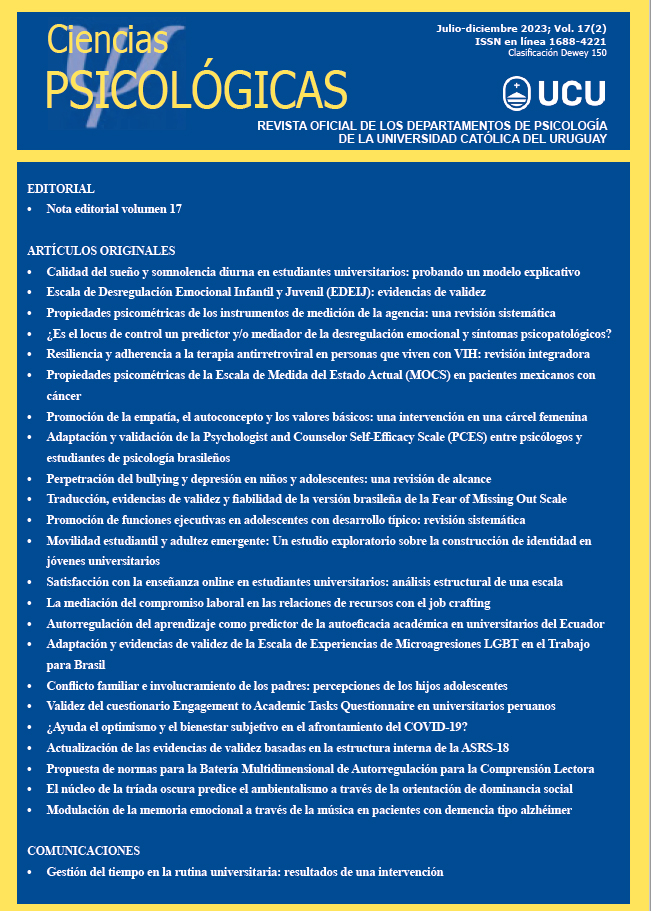Translation, validity evidence and reliability of the Brazilian Version of the Fear of Missing Out Scale
DOI:
https://doi.org/10.22235/cp.v17i2.2835Keywords:
Fear of Missing Out, psychometric properties, factor analysisAbstract
The Fear of Missing Out (FoMO) phenomenon, characterized by the distress caused by the perception of being excluded or not participating in activities in which peers are involved, is examined in this study. The FoMO Scale, comprising 10 items, is employed to measure the levels of this sentiment. The research aimed to translate, adapt, and validate the Fear of Missing Out Scale for the Brazilian context. To achieve this objective, the study followed two distinct methodological stages: the first pertained to translation and adaptation, while the second encompassed the scale's application, accompanied by an analysis of content and construct validity evidence. In the initial phase, the process involved the translation itself, followed by back-translation and subsequent evaluation by experts and the target audience. Moving on to the second stage, an exploratory factor analysis (EFA) was conducted using the Factor software, involving 646 participants aged between 18 and 63 years (M = 32.60; SD = 11.84). The exploratory factor analysis revealed the presence of a single dimension in the scale, in line with the original structure. Furthermore, the study provided two forms of valid evidence for the instrument, considering its novel application in the Brazilian context. The ability to utilize this scale in this scenario opens the door to cross-cultural studies addressing this theme.
Downloads
References
Al-Menayes, J. (2016). The fear of missing out scale: Validation of the Arabic version and correlation with social media addiction. International Journal of Applied Psychology, 6(2), 41-46.
Alt, D. (2015). College students' academic motivation, media engagement and fear of missing out. Computers in Human Behavior, 49, 111-119. https://doi.org/10.1016/j.chb.2015.02.057
Borsa, J. C.; Damásio, B. F.; Bandeira, D. R. (2012). Adaptação e validação de instrumentos psicológicos entre culturas: algumas considerações. Paidéia, 22(53), 423-432. https://doi.org/10.1590/s0103-863x2012000300014
Brown, T. A. (2006). Confirmatory factor analysis for applied research. The Guilford Press.
Casale, S., & Fioravanti, G. (2015). Satisfying needs through social networking sites: A pathway towards problematic Internet use for socially anxious people? Addictive Behaviors Reports, 1, 34-39. https://doi.org/10.1016/j.abrep.2015.03.008
Casale, S., & Fioravanti, G. (2020). Factor structure and psychometric properties of the Italian version of the fear of missing out scale in emerging adults and adolescents. Addictive Behaviors, 102, 106179. https://doi.org/10.1016/j.addbeh.2019.106179
Elhai, J. D., Yang, H., Fang, J., Bai, X., & Hall, B. J. (2020). Depression and anxiety symptoms are related to problematic smartphone use severity in Chinese young adults: Fear of missing out as a mediator. Addictive behaviors, 101, 105962. https://doi.org/10.1016/j.addbeh.2019.04.020
Ferrando, P. J., & Lorenzo-Seva, U. (2018). Assessing the quality and appropriateness of factor solutions and factor score estimates in exploratory item factor analysis. Educational and Psychological Measurement, 78, 762-780. https://doi.org/10.1177/0013164417719308
Floyd, F. & Widaman, K. (1995). Factor analysis in the development and refinement of clinical assessment instruments. Psychological Assessment, 7, 286-299. https://doi.org/10.1037/1040-3590.7.3.286
Gil, F., Del Valle, G., Oberst, U., & Chamarro, A. (2015). Nuevas tecnologías -¿Nuevas patologías? El smartphone y el fear of missing out. Aloma: Revista de Psicologia, Ciències de l’Educació i de l’Esport, 33(2), 77-83. https://doi.org/10.51698/aloma.2015.33.2.77-83
Gökler, M., Aydın, R., Unal, E., & Metintas, S. (2016). Determining validity and reliability of Turkish version of Fear of Missing out Scale. Anatolian Journal of Psychiatry, 17(1), 53. https://doi.org/10.5455/apd.195843
Laros, J. A. (2005). O uso da análise fatorial: algumas diretrizes para pesquisadores. Análise fatorial para pesquisadores, 1, 145.
Lorenzo-Seva, U., & Ferrando, P. J. (2019). Robust Promin: a method for diagonally weighted factor rotation. Liberabit: Revista Peruana de Psicología, 25(1), 99-106. https://doi.org/10.24265/liberabit.2019.v25n1.08
Milyavskaya, M., & Koestner, R. (2011). Psychological needs, motivation, and well-being: A test of self-determination theory across multiple domains. Personality and Individual Differences, 50(3), 387-391. https://doi.org/10.1016/j.paid.2010.10.029
O’Connor, B. P. (2000). SPSS and SAS programs for determining the number of components using parallel analysis and Velicer's MAP test. Behavior Research Methods, Instrumentation, and Computers, 32(3), 396-402. https://doi.org/10.3758/bf03200807
Pasquali, L. (2009). Psicometria. Revista da Escola de Enfermagem da USP, 43(spe), 992-999. https://doi.org/10.1590/s0080-62342009000500002
Perrone, M. A. (2013). #FoMO: establishing validity of the fear of missing out scale with an adolescent population. Alfred University.
Przybylski, A. K., Murayama, K., DeHaan, C. R., & Gladwell, V. (2013). Motivational, emotional, and behavioral correlates of fear of missing out. Computers in Human Behavior, 29, 1841-1848. https://doi.org/10.1016/j.chb.2013.02.014
Reeve, J. (2006). Motivação e Emoção (4a ed.). LTC.
Roberts, J. A., & David, M. E. (2020). The social media party: Fear of missing out (FoMO), social media intensity, connection, and well-being. International Journal of Human–Computer Interaction, 36(4), 386-392. https://doi.org/10.1080/10447318.2019.1646517
Ryan, R. M., & Deci, E. L. (2000). Self-determination theory and the facilitation of intrinsic motivation, social development, and well-being. American Psychologist, 55(1), 68-78. https://doi.org/10.1037/0003-066x.55.1.68
Sette, C. P., Lima, N. R., Queluz, F. N., Ferrari, B. L., & Hauck, N. (2020). The online fear of missing out inventory (ON-FoMO): Development and validation of a new tool. Journal of Technology in Behavioral Science, 5(1), 20-29. https://doi.org/10.1007/s41347-019-00110-0
Skierkowski, D., & Wood, R. M. (2012). To text or not to text? The importance of text messaging among college-aged youth. Computers in Human Behavior, 28, 744-756. https://doi.org/10.1016/j.chb.2011.11.023
Tanhan, F., Özok, H. İ., & Tayiz, V. (2022). Fear of missing out (FoMO): A current review. Psikiyatride Guncel Yaklasimlar, 14(1), 74-85.
Timmerman, M. E., & Lorenzo-Seva, U. (2011). Dimensionality Assessment of Ordered Polytomous Items with Parallel Analysis. Psychological Methods, 16, 209-220. https://doi.org/10.1037/a0023353
Wegmann, E., Oberst, U., Stodt, B., & Brand, M. (2017). Online-specific fear of missing out and Internet-use expectancies contribute to symptoms of Internet-communication disorder. Addictive Behaviors Reports, 5, 33-42. https://doi.org/10.1016/j.abrep.2017.04.001
Published
How to Cite
Issue
Section
License
Copyright (c) 2023 Universidad Católica del Uruguay

This work is licensed under a Creative Commons Attribution 4.0 International License.
















